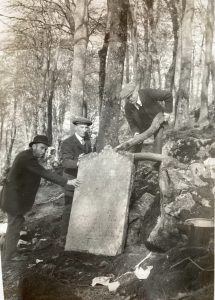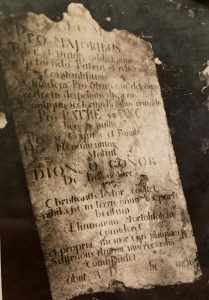Travel into History – penal law Ireland
Religious tolerance was a rare virtue in 18th century Europe so for example in France the French Huguenots were being persecuted by the majority Catholic community likewise in Spain. The Irish situation was somewhat different in that the small Protestant minority, the Protest Ascendency were oppressing the majority Catholic.
Denis O’Conor
Denis, Major Owen’s heir was born in 1674, was as it turned out, quite a remarkable man whose determined and ultimately successful efforts to recover from this hopeless situation would secure the O’Conor Family’s future over the coming three centuries. In the situation he found himself in it could be assumed that a number of choices confronted him. Possibly to convert to the Established Faith as an estimated 5,500 largely “landed” Catholics had done so between 1703 and 1789; to abandon Ireland and pursue a career in one of the armies of Catholic Europe or the Church or to resign himself and his family to the fate of a landless peasant which was the lot of so many of his countrymen.
In 1701 Denis did obtain a Court decree that he should be returned to a small portion of his ancestral lands. However, the enforcement of the decree proved exceptionally difficult and his struggle to regain possession of the lands and the worries created for him were supposed to have turned his hair prematurely grey which resulted in the nickname he was given “Donnchadh Liath” or “Denis the grey head”. It took nearly twenty years for Denis to enforce his claim. During this period, he and his family lived as landless peasants in a “bahaun” (peasants’ cottage) in Kilmactranny Co. Sligo where he sold his services as a ploughman for a shilling a day. In the words of Fr. Charles O’Conor SJ in his thesis on Charles O’Conor of Bellanagare “the place was lonely and obscure… but this was the supreme argument in its favour … it was places such as this that outlawed Irishmen fond that refuge and security denied to them elsewhere”. This experience led Denis who was selling his services as a ploughman for a shilling a day say on one occasion to his young sons “never be impudent to the poor, boys; I was the son of a gentleman but ye are the sons of a ploughman”.
Mary O’Rourke
Denis had married Mary O’Rourke of the distinguished family O’Rourkes once Kings of Breffni (an area now represented by Counties Leitrim / Cavan). Denis was greatly assisted in his legal struggles by the famous lawyer Councellor Terence Mc Donough, Mary’s uncle, the only Catholic barrister then practicing at the Bar in Dublin. In fighting his lawsuit Denis was, according to Family tradition, reputed to have walked over 100 miles to Dublin barefoot to fight his case, so impoverished was he at this time. Denis, with the help of the cooperative and liberally minded Ascendency, French family of Frenchpark and Councellor Mc Donagh, obtained a “base fee” of his confiscated lands. This type of legal interest exploited a loophole in the Penal Laws but was subject to the perpetual annual payment of £79 to the French family equivalent to the interest on the loan taken by his Uncle Major Owen.
Refuge
When he recovered some 800 acres of poor and boggy land near Bellanagare Denis constructed a modest house, the ruins of which can still be seen. This house soon became a refuge and a haven for the distressed Catholic gentry of Connacht and indeed for his own relatives and in laws. It was said “his hospitable door was never shut against those in misfortune and distress and both Catholic laymen and cleric felt at home beneath his roof”.
Included those who stayed at Bellanagare House were Mary’s mother, Isabella, Countess O’Rorke (nee McDonough), Maid of Honour, in the exiled Court of James II based at St. Germaine en Laye. Her husband had been killed fighting for the French in the Battle of Luzzara, Lombardy 1702 (part of the War of the Spanish Succession) Both Isabella’s rare 17th century portrait and that of her husband Tiernan hang at Clonalis. When she retired from the Court of James II, she came to live with her daughter in Bellanagare until she died in 1760. A further refugee was Mary’s uncle, Thaddeus O’Rorke, a former chaplain to Prince Eugene of Savoy, whose plain chalice (designed to screw apart for easy concealment), his pectoral cross and episcopal ring, the latter two believed to have been presented to him by Prince Eugene and his liturgical vestments are all at Clonalis.
Thaddeus (died 1739) an Augustinian friar became the fugitive Catholic Bishop of Killala having been consecrated Bishop in Newgate Prison 1707 by the sole remaining in Catholic Bishop in Ireland, Bishop O’Donnelly. Among the archives at Clonalis is a copy of a Letter of Safe Conduct from Emporor Leopold 1 to Queen Ann relating to O’Rorke’s return to Ireland.
Turlough Carolan
Turlough Carolan (1670-1738) regarded as the last and most distinguished of the Irish Bards was a frequent visitor to Bellanagare. Denis jointly holds the honour of being Carolan’s co-patrons with Madame Mac Dermot Roe of Alderford. Much of what is known of the life of Turlough Carolan comes from the diaries of Denis’s son, Charles.
Inspired by the sanctuary that Bellanagare House afforded, Carolan said one day “I think when I am among the O’Conors at Bellanagare the harp has the old sound in it”. “No, replied Mc Cabe, another harper of great repute “but your soul has the old madness in it” Carolan composed three airs in honour of members of the household known as “Denis O’Conor”, “Charles O’Conor” and “Maire (Mary) O’Rourke”, Denis’s wife. After Carolan’s death his harp was given to the O’Conors of Bellanagare. It now forms part of the collection at Clonalis.
Douglas Hyde
In 1917 in an old graveyard near Bellanagare workmen unearthed an inscribed headstone. The inscription in Latin was translated by Douglas Hyde, a scholar of major significance and soon to become Ireland’s First President. It provides an interesting insight into what inspired Denis O’Conor during his lifetime and is an epitaph not only to Denis’s forebears but for Penal Law Ireland. The translation reads as follows:
“For his Ancestors and his Father and Grandfather here buried, who were to Faith and Virtue most addicted,
And to Religion and Fatherland most constant
But who for the defence of both,
Were reduced, despoiled, dispersed.
This monument was erected by Denis O’Conor of Bellanagare in 1735 ……”
It is probable this gravestone was to have been placed on the Family tomb in Ballintober but for some reason was not used. It is now in the Dell Garden at Clonalis.
Denis O’Conor, this unsung hero of the O’Conor family died in 1750.
Pyers O’Conor Nash
The gravestone of 1735 unearthed in Kilcorkey Bellanagare in 1917

